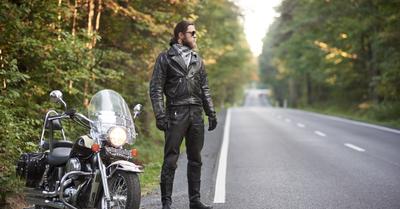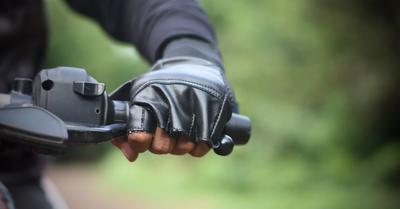What Gear to Choose When Riding Uphill on a Motorcycle
To understand which gear to select when going uphill, we need to look at two different scenarios. First, what gear to choose when you want to maintain speed when climbing uphill and second, which gear to choose when you come to a stop and want to start again.
Which Gear to Choose When Maintaining Speed Riding Uphill
According to my experience, maintaining your speed uphill is easier to do than starting your motorcycle when you have come to a stop uphill. So we will start with the former first.
Understanding the RPM When Shifting Gears
To keep your bike going smoothly uphill, you will need to pay attention to your transmission and downshift gears appropriately to ensure they match the engine’s rpm.
The load on your engine is associated with the rpm that is measured by the dials in your motorcycle. To manage a steep hill climb, you will need to consider your motorcycle’s rpm. That’s because, if you notice, when you shift your gears, your bike’s rpm will drop with every shift.
The gear ratio for each gear is different. As you shift the gear, it will also change the load on the engine. Your bike’s engine will take on the heaviest load when the motorcycle is at a low rpm and is trying to speed up. Many motorcycles these days are manufactured so that they operate optimally above 5000 rpm. SO, if your motorcycle is below 2,000 rpm and is trying to accelerate, it will place a bigger load on its engine. You need to manage this engine load in the right way as this is the difference between a good rider and one that needs more practice.
Hence, if you want to ensure a smooth ride uphill, you want to make sure that the gear you choose aligns nice and steady with your motorcycle’s rpm. As you speed up your bike, your rpm will rise, and you will need to upshift to a higher gear to make sure your bike doesn’t become rocky. However, when you are going uphill, the trick is that your bike’s rpm will start to drop. So even if you roll on the throttle to accelerate, your bike may start to shake since it is not getting enough power to run on the higher gear.
This means that the load on your engine is higher and if you do not change your gear soon, your motorcycle may stall in the middle of the road. Hence, it is important to understand that when you are traveling uphill and you notice your rpm is dropping, you need to drop one and sometimes even two gears. For example, if you are traveling on the fourth gear on an even and straight road and you transition to a steep hill, your rpm will drop and you will quickly need to shift to the third and maybe downshift again to the second gear to make sure your motorcycle remains moving.
When selecting the appropriate gear for the uphill ride, you will be able to control and manage the load on your motorcycle’s engine and will stay safe while you are moving. In short, when going uphill on a motorcycle, you should always choose a gear that offers you the smoothest engine operation and a jerk-free ride.
You may not be able to get the hang of it in one try, but with enough practice, it will become easier to understand how your motorcycle behaves in various riding conditions and what you need to do to manage it.
Which Gear to Choose When Pulling Away From a Stop When Going Uphill?
I remember my first time riding up a steep hill and the light turned red. Although stopping the motorcycle and applying the brakes was easy enough, I was in cold sweats thinking about what would happen when the light turned green and I had to pull away.
To make sure you have a good stop and start uphill, you need to pre-plan. Before you even stop, you need to be in first gear. This means that when you are slowing down for a red light, you will be quickly downshifting until you reach the first gear. You do not want to brace your left foot on the ground only to realize that you have stopped in second or third gear and need to downshift to first gear to pull away. This is not a good habit and you will not have time to do this in case of an emergency. So make sure you are always in first gear when stopping.
When the light turns green and you need to pull away, you need to consider three things: the throttle, the brake, and the clutch. All of these things will be working simultaneously to make sure your bike moves forward rather than roll back into oncoming traffic. Let’s look at these steps one by one.
The Throttle
When you are climbing up an incline, you will need to give your engine more gas than if you were driving on flat ground. This is because your bike needs to fight the pull of gravity that is trying to roll it back down.
You will also need to keep revving your bike since you do not want it to stall. Since the rpm gets low uphill, your bike can stall easier. Do not be afraid of lurching forward unless your brakes are not applied or you suddenly drop the clutch.
Keep increasing your throttle and hold them steady. Once you feel the bike will no longer roll back, the next thing to do is to make it move forward. This means giving even more gas to your engine.
The Clutch
The clutch is very important to control the increased revs you are sending to the rear wheel of the motorcycle. The clutch basically takes on the main responsibility of your brakes when you are on a steep hill and prevents you from rolling back. This allows you to take the pressure off the brakes without rolling downhill.
When getting the revs up, slowly and gradually release the clutch until you are in the friction zone and you feel the motorcycle’s engine fight the brakes. When this happens, hold the clutch there and release the brakes completely and your bike will start to move upwards.
The Brakes
Once you feel your revs are up and steady and your clutch has achieved the friction zone, you will feel your engine trying to move your bike forward. This is the perfect point to be. At this point, you will gently release your brakes and your motorcycle will move forward.
If your bike is still holding its ground, you need to send more power to the wheels by applying the throttle and letting out the clutch a bit more. If you feel yourself rolling back, quickly reapply the brakes and try again, this time with a bit more rev and a little less clutch.
Once you start to move, apply a bit more throttle to make sure your motorcycle does not start to jerk or stall. As you pick up momentum, shift to the second gear and to other higher gears, making sure you are matching the rpm and enjoying a smooth ride.
In short, make sure your motorcycle is in first gear, apply the brakes, increase the revs and allow the clutch to slip into the friction zone. Slowly and gradually release the front and rear brakes. Increase your throttle and let out a bit more clutch to stop yourself from rolling backward or stalling and encourage your bike to move forward.
I hope this guide helped reduce some of your anxiety and made you better understand how to properly operate your bike uphill. With some practice, you will soon become a pro and it will become second nature to you to apply the correct gear and work your bike the right way.
Happy riding!















